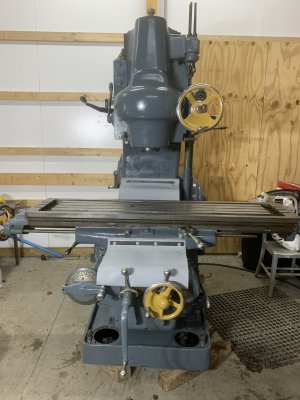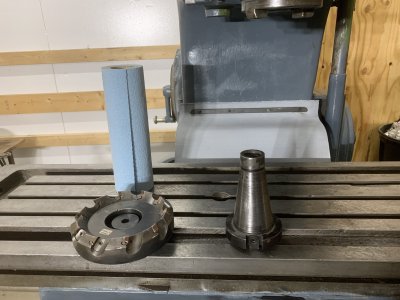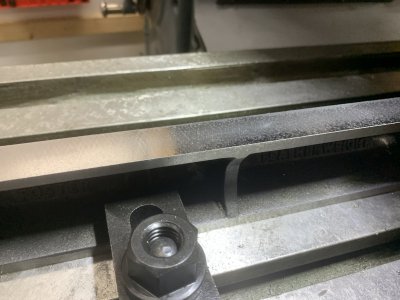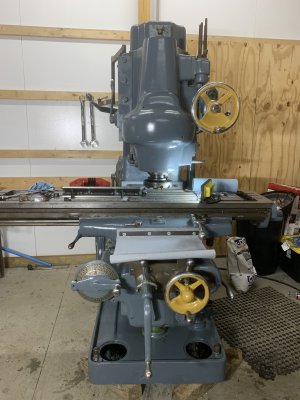-
Welcome back Guest! Did you know you can mentor other members here at H-M? If not, please check out our Relaunch of Hobby Machinist Mentoring Program!
You are using an out of date browser. It may not display this or other websites correctly.
You should upgrade or use an alternative browser.
You should upgrade or use an alternative browser.
Just acquired K&T #3 vertical
- Thread starter rabler
- Start date
- Joined
- Feb 25, 2021
- Messages
- 3,130
Yeah, "matched" in my mind meant two vises of the same model. I realize it is possible to order new vises as a pair from Kurt with precision matching for extreme accuracy, I'm never going to be working at that level of precision.You dont need a matched set of vices, buy a used pair and tweak them , about the only difference you would need to worry about is height.
I saw good used Kurt vives at HGR last week
- Joined
- Jan 2, 2014
- Messages
- 8,853
That is fantastic!
I love to see old tech brought back to use.
I am still considering a DRO on my 1916 Cincinnati mill almost as much for the old/new contrast as for the obvious value on a old, worn machine.
My advice: you do not need multiple new vises.
1) Find a great quality used vise with no fancy stuff (rotary table, tilt, etc.) and bolt it down near the middle of the table.
2) Then add a rotary table to one side, perhaps with a mount the same as your lathe spindle for 3-jaw and 4-jaw chucks,
3) leave some table space to the other side for bolting things down directly to the table.
4) maybe add a small 3-4" tilt, swivel vise for them odd-ball projects.
Please keep posting.
That is a beautiful piece of history you have!
-brino
I love to see old tech brought back to use.
I am still considering a DRO on my 1916 Cincinnati mill almost as much for the old/new contrast as for the obvious value on a old, worn machine.
My advice: you do not need multiple new vises.
1) Find a great quality used vise with no fancy stuff (rotary table, tilt, etc.) and bolt it down near the middle of the table.
2) Then add a rotary table to one side, perhaps with a mount the same as your lathe spindle for 3-jaw and 4-jaw chucks,
3) leave some table space to the other side for bolting things down directly to the table.
4) maybe add a small 3-4" tilt, swivel vise for them odd-ball projects.
Please keep posting.
That is a beautiful piece of history you have!
-brino
- Joined
- Feb 25, 2021
- Messages
- 3,130
By that logic, I don't *need* this mill.My advice: you do not need multiple new vises.
- Joined
- Feb 25, 2021
- Messages
- 3,130
About time to actually try out making some chips with this beast.
Got the new way covers made up and installed. Knee and headstock has been flushed and refilled. The table has been cleaned and stoned. I've powered it up and run it without actually cutting serveral times. There's plenty more I could do to fix it up,
I have a simple cut in mind, I have a raw casting of a 16" straight edge that I want to mill. I've already run it once through my other mill, but with a 2.5" face mill it took two passes to get the width, and I still need to do the angled face. So I'm going to put this to work. But first I need to get my face mill together. The arbor I have is about 0.050 too long so it doesn't tighten down on the face mill. Clamping the arbor in a lathe would be possible but the taper makes that complex, so instead I'm gong to put the arbor into the spindle, and clamp a lathe tool to the table, probably my 3/4"x 3/4" WNMG holder, and run the arbor over that. If that is successful, then I will go on to milling the straight edge.
Progress report in a day or two.


Got the new way covers made up and installed. Knee and headstock has been flushed and refilled. The table has been cleaned and stoned. I've powered it up and run it without actually cutting serveral times. There's plenty more I could do to fix it up,
- New belts,
- Drain flush and refill the main column reservoir,
- New way wipers
I have a simple cut in mind, I have a raw casting of a 16" straight edge that I want to mill. I've already run it once through my other mill, but with a 2.5" face mill it took two passes to get the width, and I still need to do the angled face. So I'm going to put this to work. But first I need to get my face mill together. The arbor I have is about 0.050 too long so it doesn't tighten down on the face mill. Clamping the arbor in a lathe would be possible but the taper makes that complex, so instead I'm gong to put the arbor into the spindle, and clamp a lathe tool to the table, probably my 3/4"x 3/4" WNMG holder, and run the arbor over that. If that is successful, then I will go on to milling the straight edge.
Progress report in a day or two.


- Joined
- Nov 24, 2014
- Messages
- 3,179
I wonder how hard the arbor is? File test?
Do you have a CBN tool if the arbor is too hard for carbide?
Could a special "C" or "hat" section washer (on the screw side) straddle the .050" extra arbor length?
I would suggest making a washer/spacer rather than modifying the arbor. YMMV
Do you have a CBN tool if the arbor is too hard for carbide?
Could a special "C" or "hat" section washer (on the screw side) straddle the .050" extra arbor length?
I would suggest making a washer/spacer rather than modifying the arbor. YMMV
- Joined
- Feb 25, 2021
- Messages
- 3,130
Haven't file checked it yet. Pre-concept stage only so working on this. The problem with the washer concept is that there is a bit of geometry to the underside of the bolt that goes with the arbor. Of course shortening the arbor alone doesn't solve this. I have a lathe or three so turning a complex washer is certainly possible. The lathe is just in the other shop so I'll be doing some running back and forth. I'll be back at the shop with the mill tonight, and will start pondering all of the details at that point. And may have to bring the cutter and arbor back to the shop by the house to have it in hand for the lathe work. New shop hopefully soon, all metalworking in one place.I wonder how hard the arbor is? File test?
Do you have a CBN tool if the arbor is too hard for carbide?
Could a special "C" or "hat" section washer (on the screw side) straddle the .050" extra arbor length?
I would suggest making a washer/spacer rather than modifying the arbor. YMMV
Last edited:
- Joined
- Feb 25, 2021
- Messages
- 3,130
Hardened arbor, came back and turned a washer with a matching shoulder to register on the bolt. Wish I had a functional surface grinder to get that washer a bit more polished. .Could hand stone it a bit. But darn it, I’m eager to make something happen with the K&T!
- Joined
- Feb 25, 2021
- Messages
- 3,130
To put that face mill and arbor into the mill, I set the assembly on a paint can and lowered the head onto the mill. Because I wasn't strong enough to hold the thirty pounds up one handed while standing on a ladder to get the drawbar started. Then I realized I don't have wrenches suitable for tightening the drawbar, two 1-5/8". So I ordered a couple of those through Amazon for Friday delivery.
Obviously this mill is not going to be the goto mill for most projects! Fortunately I have something in a more manageable size for "run of the mill" projects.
Obviously this mill is not going to be the goto mill for most projects! Fortunately I have something in a more manageable size for "run of the mill" projects.
- Joined
- Feb 25, 2021
- Messages
- 3,130
Chips were successfully made! Always fun to make the first cuts with a new machine. Even if the machine is 77 years old.
This was a very light cut, about a .005" depth of cut, .002" per tooth, with a 6" face mill. 385 RPM and 7.25 IPM. Using steel inserts on cast iron, finish was good. Also happy to see the tramming is good, because the only way to adjust would be rescraping the bed or head of the mill.
Minor challenge, the mill is listed as 11/16" slots on the vintagemachinery.org information I could find, so I ordered a 11/16ths hold down kit from Shars. The T-nuts that arrived would not fit. Table measured about .671 for the slots. 11/16ths should be .685. The T-nuts measured .690 - .701 Some work on the Grizzly mill to reduce the T-nuts to .670. Unfortunately 2 t-nuts got munched in the process do to an operator error. Easy enough to make more.


This was a very light cut, about a .005" depth of cut, .002" per tooth, with a 6" face mill. 385 RPM and 7.25 IPM. Using steel inserts on cast iron, finish was good. Also happy to see the tramming is good, because the only way to adjust would be rescraping the bed or head of the mill.
Minor challenge, the mill is listed as 11/16" slots on the vintagemachinery.org information I could find, so I ordered a 11/16ths hold down kit from Shars. The T-nuts that arrived would not fit. Table measured about .671 for the slots. 11/16ths should be .685. The T-nuts measured .690 - .701 Some work on the Grizzly mill to reduce the T-nuts to .670. Unfortunately 2 t-nuts got munched in the process do to an operator error. Easy enough to make more.


Last edited:

